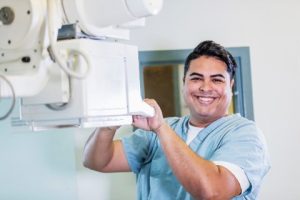 Radiology technicians take diagnostic images lives and in two dimensions. Radiology technicians are valuable members of the multidisciplinary healthcare team that contribute to quality patient care by performing X-rays for doctors to diagnose bone fractures and other conditions from cancer and arthritis to the entire gastrointestinal system.
Radiology technicians take diagnostic images lives and in two dimensions. Radiology technicians are valuable members of the multidisciplinary healthcare team that contribute to quality patient care by performing X-rays for doctors to diagnose bone fractures and other conditions from cancer and arthritis to the entire gastrointestinal system.
As part of the allied health field, radiology technicians are the third largest group of healthcare professionals, after doctors and nurses. They require a level of skill that only an associate degree program can provide.
What Does a Radiology Technician Do?
Radiologic technicians operate the medical imaging equipment to produce radiographic images of internal body structures. They do not interpret X-rays, but they manage the process from equipment selection and patient positioning to the evaluation image of quality.
Their key responsibilities include:
Performing Imaging Procedures
Radiology technicians use medical imaging equipment to perform X-rays. They follow established procedures for capturing medical images as ordered by a physician.
Patient Preparation
Radiology technicians prepare patients for examinations, explaining the purpose and procedure for each study. They answer questions, offer the appropriate apparel, and provide reassurance to alleviate concerns related to the imaging process.
Patient Positioning
Patient positioning affects the quality of X-rays. Radiology technicians guide patients into position, adjusting the body position for the head, upper and lower limbs, abdomen, and chest. Radiology Technologists also prepare the equipment settings to achieve the desired images.
Ensuring Image Quality
Radiology technicians adjust equipment settings, exposure factors, and positioning to optimize X-ray quality while minimizing radiation dose. The goal is to provide doctors with proper image quality.
Maintaining Radiation Safety
Ensuring the safety of patients is a radiology technician’s foremost priority. They adhere to radiation safety guidelines, use proper shielding, and employ techniques to minimize patient exposure to ionizing radiation.
Image Processing
Like photos, X-rays must be developed or digitized before viewing. After acquiring images, radiology technicians process them using film processing, computerized images, and digital imaging.
Quality Control
Quality images are essential for accurate diagnoses because poor image quality can result in delayed or incorrect diagnoses. Radiology technicians review X-rays to ensure they meet diagnostic standards. They troubleshoot positioning and equipment settings and retake the images if any issues arise.
Assisting Radiologists and Physicians
Radiology technicians may assist radiologists or physicians during specialized imaging procedures, such as Fluoroscopy, Operating Rooms, and interventional radiology with image-guided biopsies.
Maintaining Radiology Equipment and Supplies
Radiology technicians are responsible for cleaning and maintaining imaging equipment, ensuring that all necessary supplies and accessories are available for each imaging procedure.
Recordkeeping
Radiology techs maintain accurate and detailed records of imaging procedures, patient information, and any relevant findings or observations.
Collaboration with Healthcare Professionals
Radiology technicians collaborate closely with radiologists, physicians, and other healthcare professionals. They discuss imaging findings and help interpret the images to aid in patient diagnosis and treatment planning.
Why Do I Need an Associate Degree to Become a Radiology Technician?
Radiology technicians must have an associate degree for several important reasons:
Technical Expertise
Radiology is a specialized field that requires a strong foundation in both theoretical knowledge and practical skills. An associate degree program provides comprehensive education, ensuring that radiology technicians have the confidence and technical expertise to operate complex medical imaging equipment and produce quality diagnostic images.
Safety
Radiology technicians and patient exposure to radiation occur during the imaging process. An associate degree program includes courses on dose management and safety procedures necessary to maintain a safe working environment.
Professional Standards
Requiring an associate degree helps maintain high professional standards in the radiology field. Patients and healthcare providers feel more confident knowing that technicians receive a standardized and well-rounded education that meets the requirements set by regulatory bodies and accrediting agencies.
Licensure and Certification
Most states require a license or certificate to work as a radiology technician; an associate degree is the minimum prerequisite for eligibility. It is also the foundation for most specialty certifications, a plus for taking your practice to the next level.
What Do I Learn in a Radiology Technician Degree Program?
Associate degree programs cover what you need to know to succeed as a radiology technician. The curriculum blends theory with laboratory and clinical experiences to provide a comprehensive education.
Prerequisites and core courses include:
Human Biology
Human biology is the study of the structures and functions of the human body. Radiology students will relate lessons to real-world applications. You will explore the basics of biology, from learning cellular structure and genetics to human development and aging, therefore gaining a deeper understanding of how human biology affects health and the radiography process.
Anatomy and Physiology
Anatomy and physiology courses dive deeper into the body, examining tissue structure and organ systems. Understanding the location, function, and orientation of organs, bones, and tissues helps radiologic technologists produce high-quality images that provide accurate diagnostic information.
Medical Terminology
Medical terminology is the specialized language the healthcare community uses to describe body parts, anatomical directions, treatments, disorders, and procedures. Terms are combinations of root words, prefixes, and suffixes that give them a specific meaning. Understanding this standardized and universal communication system among healthcare professionals helps radiology technicians interpret physicians’ orders and engage with colleagues.
Introduction to Healthcare
Radiology technicians are part of the medical community, so understanding the foundational concepts of the industry is essential for working within the system. This course covers the principles related to the broader healthcare field and includes a comprehensive healthcare system overview. Students discuss the roles and responsibilities of healthcare professionals, communication skills, cultural competency, healthcare regulations, and medical ethics.
Patient Care Procedures
Radiologic technicians work closely with patients during imaging procedures, providing hands-on assistance and guidance. This course emphasizes the importance of patient comfort, safety, and communication.
You will learn practical techniques for evaluating and positioning patients, including how to use assessment tools, such as measuring devices and positioning aids. Also covered are infection control, patient privacy, accommodations for special populations, and emergency preparedness. Graduates develop the skills and knowledge necessary to provide compassionate, safe, patient-centered care during medical imaging procedures.
Radiation Protection and Radiobiology
Radiologic technicians must adhere to strict safety protocols to protect themselves and their patients from unnecessary radiation exposure. In this course, you will learn about the biological effects of ionizing radiation on the human body and the responsible use of medical imaging equipment. The focus is on radiation production, control, and detection in medical settings.
Students review the national and international radiation protection standards, regulations, and guidelines that govern the safe use of ionizing radiation in medical imaging, learning their legal responsibilities and the importance of adhering to safety guidelines.
Image Production and Evaluation
This course explores X-ray physics, including the principles of X-rays, interactions with matter, and radiation safety. Students learn how to produce quality images and assess their diagnostic value. Topics include imaging techniques, exposure times, equipment performance, artifacts, and other factors contributing to image quality.
Also emphasized is the importance of quality assurance and quality control practices in medical imaging. Following policies, procedures, and protocols ensures consistency.
Equipment Operation
Students in this hands-on course are introduced to X-ray equipment. You will learn about the various components within an X-ray unit, such as the X-ray tube, collimator, and control panel, and how they function. Students learn to use fixed and mobile X-ray units, making the most of their distinct capabilities. Here, you will master how to adjust exposure settings for different imaging studies and how to calibrate and maintain the machines.
Radiographic Positioning and Related Anatomy
In a radiographic positioning course, students receive specialized training on positioning patients for comfort and optimal images. The focus is on the different body positions and techniques required to X-ray specific body parts.
Technicians-in-training learn to identify the anatomical landmarks that serve as reference points for accurate positioning and alignment during imaging. You will study the proper placement of the image receptor (the X-ray film or digital detector) and how to position grids appropriately for studies of different body areas, from the skull to the abdomen.
Radiographic Pathology
Understanding the common abnormalities that appear on radiographs is essential for radiology technicians. Only by recognizing what is normal and abnormal can you help identify potential issues with images and communicate findings to radiologists and other healthcare professionals. Students will study the radiological manifestations of common traumatic injuries, infections, degenerative diseases, and congenital irregularities.
Radiographic Clinical
Practical experience is a crucial part of a radiology technology program. Clinical experience allows students to apply theoretical knowledge in real-world settings. Under the supervision of instructors and experienced technicians, you will develop practical skills in patient care, imaging techniques, equipment operation, and radiological safety.
Also, emphasize your role as a member of the healthcare team. Clinical experiences are your first chance to interact with future colleagues. It is the ideal time to refine your communication skills and make an impression on potential employers. By graduation day, you will feel like a full-fledged radiology technician.
Clinical Journal in Radiology
Clinical journaling encourages students to reflect on their experiences and observations during training. The goal is to develop self-awareness by documenting their journey. You will develop a stronger sense of your professional identity and career goals through reflective writing about your cases and interactions with patients and colleagues.
Instructors will review your journal periodically to help you pull insights from its pages, providing feedback to help you get everything possible out of the experience. You will learn to analyze your thoughts and decision-making processes, identifying areas of strength and areas for improvement.
Final Thoughts
Two years is a long time to study, but an associate degree is the foundation for success in the radiology field. More than a piece of paper, it reflects your knowledge, dedication, and professionalism.
Eager to Learn More?
The Radiologic Technology Degree prepares the student, upon successful completion of the Certifying Examination, for a position as a member of a health care team in a hospital, clinic or physician’s office. The degree can open doors to other opportunities, including manufacturing and supplying medical equipment or management. This program is designed to prepare the student for the National Certifying Examination by the American Registry of Radiologic Technologists and for the State of Florida Dept. of Health and Rehabilitative Service General License Examination. The program also includes a fifteen-credit-hour component of general education/liberal arts courses. FNU awards an Associate of Science Degree upon graduation.
If you are interested in Radiologic Technology, let Florida National University answer any questions you may have. Contact us today to learn more about our Radiologic Technology programs.



